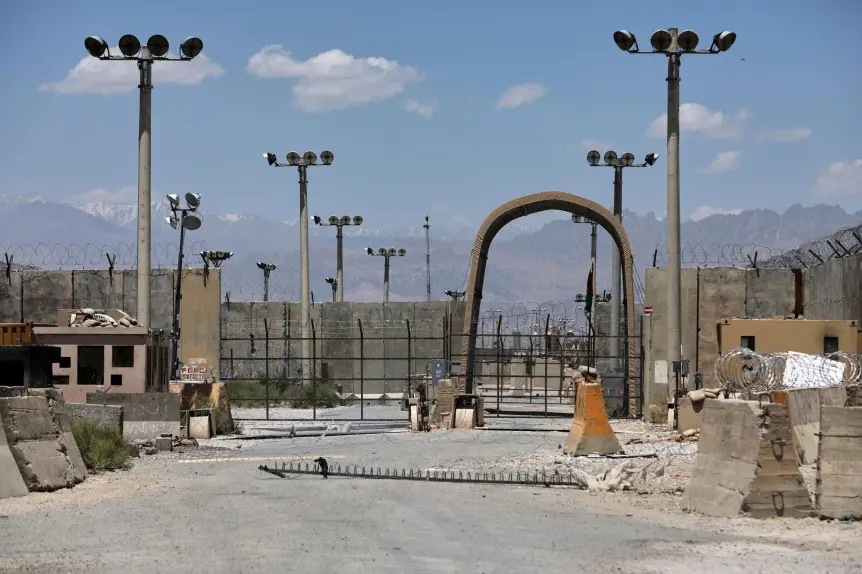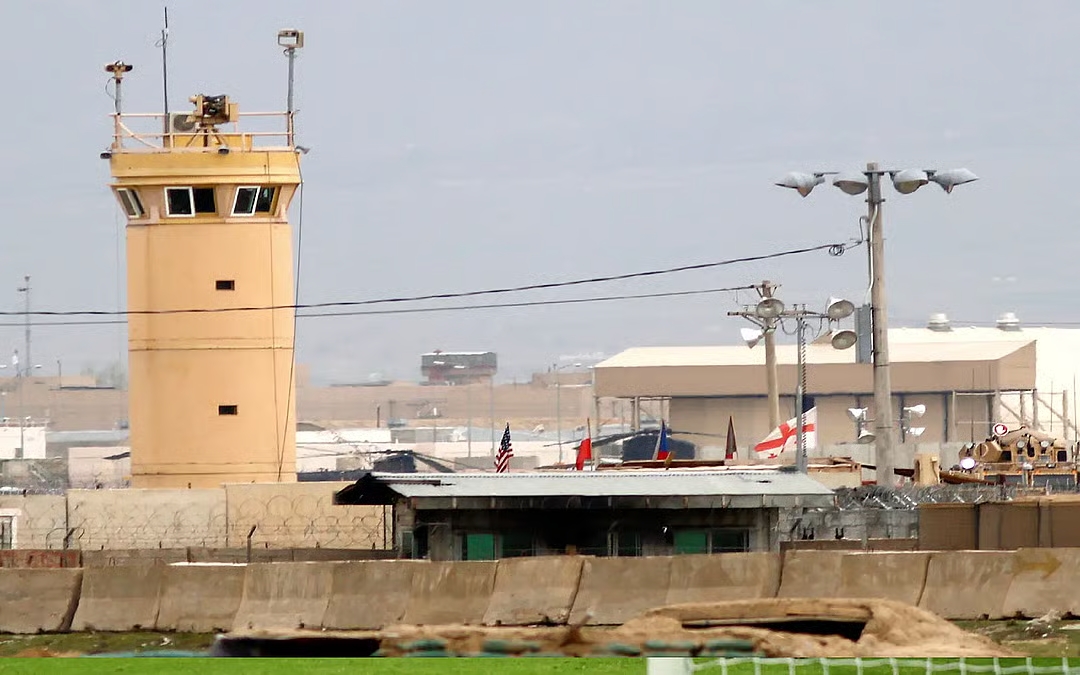Donald Trump is threatening to retake Bagram Air Base to gain access to Afghanistan’s rich mineral deposits and to check China and other countries. It’s a costly fantasy. Trump himself signed the 2020 Doha Accord, and his about-face reveals a foreign policy driven by political revenge.

A gate is seen at the Bagram Air Base in Afghanistan, Friday, June 25, 2021. The Taliban government has rejected U.S. President Donald Trump’s bid to retake Bagram Air Base, four years after America’s chaotic withdrawal from Afghanistan left the sprawling military facility in the Taliban’s hands.U.S. (AP file photo)
The abrupt announcement by U.S. President Donald Trump in September that he seeks to “re-take” Afghanistan’s Bagram Air Base is a stark contrast to America’s 2021 withdrawal. Unlike the ideological crusades of the neoconservatives and the liberal internationalism of his predecessors, Trump’s approach is guided by a sober calculation of national interest defined narrowly in terms of power, security and economic gain. The move also exemplifies the core tenets of Trump’s foreign policy doctrine: transactional realism, zero-sum competition and strategic opportunism.
Afghanistan occupies a pivotal position at the crossroads of Central Asia, South Asia and the Middle East. Bagram Air Base was the logistical and operational heart of the U.S. war effort for two decades. Trump’s demand to take it back is driven by the base’s unrivaled strategic value.
First, the U.S. aims for regional dominance. From Bagram, it can project power eastward toward China, westward against Iran, southward to Pakistan and India and northward into resource-rich Central Asia.
Second, the Washington wants to fill a strategic vacuum. Since the 2021 withdrawal, China and Russia have expanded diplomatic and economic ties with the Taliban-led government. By shouldering back in, Trump wants to disrupt this development and reassert U.S. primacy in a region where he perceives rivals gaining ground.
Third, the cost of inaction is huge. As regional powers such as Turkey, Iran and Russia compete for influence, Trump’s team views retreat as equivalent to surrendering a critical node in the 19th century “Great Game” between the British and Russian empires.
But the most important thing — which Trump should not ignore — is the response of the Taliban-led government, which gave him a blunt rejection. It said the Afghans would fight for 20 more years, and signaled that retaking Bagram would reignite the war, even if it is deemed unwinnable for them.
Containing China
Trump explicitly framed Bagram’s value through a Sinophobic lens, noting that “It’s one hour from China’s nuclear facilities.” This rhetoric, however, may not be accurate. As one analyst observed, even supersonic B-1B bombers would require four or five hours to reach targets in western China. Therefore, it makes more sense to view Trump’s words as an empty political sound bite rather than a military assessment.
Bagram’s true value lies in enabling intelligence gathering on China’s western military activities, disrupting the China-Pakistan Economic Corridor and positioning military assets near Xinjiang, which is a core Chinese security concern. Therefore, retaking Bagram will complicate China’s western flank, forcing the country to divert security resources and potentially negotiate with the U.S. on terms favorable to Washington. What’s more, the idea aligns with Trump’s Indo-Pacific Strategy, extending a chain of military pressure points from the South China Sea into Central Asia.
China’s Foreign Ministry spokesman Lin Jian responded directly to Trump’s remarks during a news briefing on Sept. 19. He criticized the U.S. for “escalating tensions and provoking confrontation” and saying such actions are “not in the interest of regional peace.” He urged all parties to “play a constructive role in stability.”
Grabbing natural resources
Afghanistan, one of the world’s poorest countries, has untapped mineral wealth estimated to be worth more than $1 trillion. It has vast deposits of lithium, copper and rare earth elements — all critical for modern technology and green energy. In fact, the U.S. government has long coveted the country’s rich natural resources. As the New York Times reported, in 2006 the George W. Bush administration conducted aerial surveys of the country to map its mineral resources, and under President Barack Obama the Pentagon set up a task force to create a mining industry in Afghanistan — a challenge that was stymied by rampant corruption, as well as by security problems and the lack of roads, bridges or railroads.
The first Trump administration explicitly mentioned this resource potential. A return to Afghanistan driven by a realist would likely involve securing access to these resources for American companies, translating a military presence into economic advantage. This would not be a humanitarian effort to develop the Afghan economy for the local people but rather a transactional strategy to ensure that these critical minerals do not fall into the hands of competitors, such as China.
By establishing a security framework, the U.S. could create conditions favorable for American investment and extraction, thereby strengthening its own supply chain security for advanced electronics and military hardware while simultaneously denying a strategic asset to a rival. This is basic economic statecraft: using national power to secure national wealth.

A view of U.S. Bagram airbase in the outskirts of Kabul, Afghanistan. (File photo: EPA Images)
Reversing Biden’s policy
Trump’s demand to “retake Bagram” is in line with his broader mission to undo his predecessor’s political heritage. By labeling Joe Biden’s 2021 withdrawal a “disgraceful disaster,” Trump uses Bagram to humiliate his predecessor and position himself as the strong alternative. Like quitting the Paris Agreement or WHO membership, Trump’s return to power has brought a systematic dismantling of Biden’s policies. More than 100 of Biden’s executive orders were reversed in Trump’s first two months alone.
The threat to seize Bagram by military force rallies Trump’s base with “tough-on-China” rhetoric ahead of the 2026 midterm elections, despite minimal feasibility. Yet the irony is profound: Trump himself signed the 2020 Doha Accord, which pledged full withdrawal. His about-face reveals a foreign policy driven by political revenge, not strategic coherence.
Trump has hinted that the Taliban needs certain things from the U.S., which may include international recognition, regaining Afghanistan’s UN seat and the release of approximately $7 billion in frozen Afghan assets. Trump has said, “We’re trying to get it back because they need things from us.”
But the Taliban government has taken a resolute stance in opposition. Afghan Army Chief of Staff Fatrullah Fasih said that “any compromise on the Bagram Air Base issue is completely unacceptable.” Foreign Minister Amir Khan Muttaqi further declared that even if the U.S. fully recognized Afghanistan and rebuilt the entire country, it would not be sufficient compensation for giving up Bagram.
Trump’s bid for Bagram showcases a foreign policy with realism at the core. Power is leverage, alliances are transactions and principles bend to opportunity. But realism without pragmatism is folly. The Taliban’s defiance, China’s entrenched regional role and America’s war fatigue make reoccupation a costly fantasy — one that could burn $200 billion annually to hold a base the Taliban already converted into textile factories.
In the end, a Trump return to Afghanistan reflects less a grand strategy than a nostalgic gambit for relevance in a multipolar world that has moved on. As the Taliban warned, some conflicts are best left in the past.
